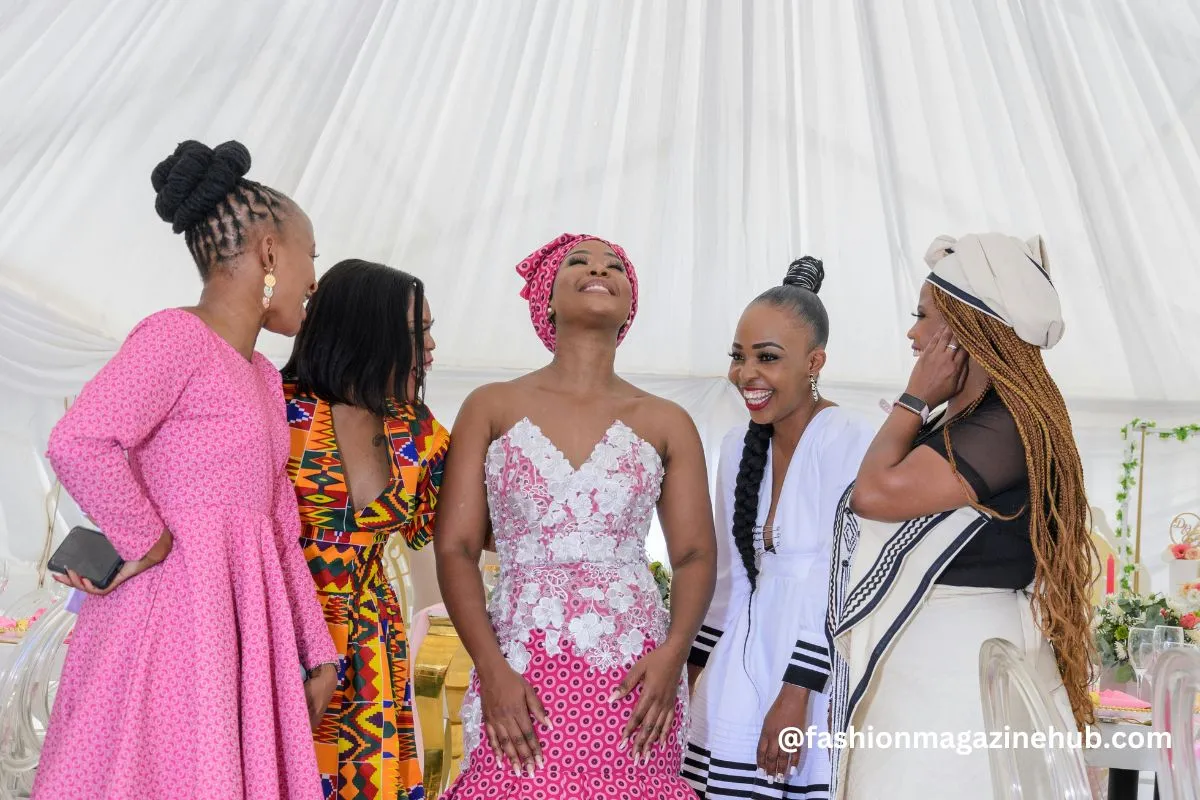African Fashion Dresses: A Journey from Bark Cloths TO Wax Prints
African fashion dresses represent more than just garments; they embody centuries of cultural heritage, artistic expression, and community identity across the diverse landscapes of Africa. From the intricate weaving techniques of West Africa to the vibrant wax prints of East Africa, each dress tells a story of tradition and innovation. In recent years, African fashion dresses have transcended borders, captivating global audiences with their bold colors, symbolic patterns, and sustainable practices. This introduction explores the evolution of African fashion dresses, their cultural significance, and their growing influence on the international fashion scene.
African Fashion Dresses: Historical Roots
African fashion dresses trace their origins to ancient times, where traditional attire was crafted from natural materials like bark cloths, animal skins, and plant fibers. These early garments served practical purposes in warm climates, with styles varying widely across the continent’s diverse regions. Clothing not only protected wearers but also conveyed social status, cultural identity, and often marked significant life events such as weddings or ceremonies. Over centuries, African fashion evolved through intricate weaving techniques, vibrant dyeing methods, and the incorporation of symbolic patterns and colors. Each ethnic group developed unique clothing traditions, reflecting their beliefs, customs, and environment. Today, understanding the historical roots of African fashion dresses helps appreciate their cultural significance and ongoing influence in global fashion trends.
From Bark Cloths To Textiles
African fashion dresses have a rich history rooted in the ingenious use of natural materials like bark cloths, furs, and skins. These early fabrics were shaped by the continent’s diverse climates, with garments designed not just for practicality but also as expressions of cultural identity. For instance, loincloths and aprons were common among men, while women adorned themselves with wraps that varied in style and adornment across different regions. These early forms of dress not only provided protection but also communicated social status and cultural traditions, evolving over centuries within distinct ethnic groups.
Cultural Significance
Across Africa, clothing holds profound cultural significance, playing pivotal roles in rites of passage, ceremonies, and daily life. Colors and patterns embedded in fabrics often symbolize aspects of community identity and spiritual beliefs. For example, among the Kuba people of Central Africa, intricate designs on ceremonial garments like the ‘bwaantshy’ serve as visual narratives of lineage and social status. Understanding these cultural nuances is essential to appreciating the depth and diversity of African fashion dresses throughout history.
Transformation To Wax Prints
The transformation to wax prints revolutionized African fashion dresses, introducing vibrant, patterned fabrics that became iconic across the continent. Originating from Indonesian batik techniques, wax prints were adapted to West African tastes during the colonial era and later manufactured locally. These prints feature bold designs, often symbolic of cultural motifs and narratives, and gained popularity for their durability and aesthetic appeal. Wax prints, known by various names like Ankara (in Nigeria) or Kitenge (in East Africa), became integral to traditional and contemporary African dress, bridging the gap between heritage and modernity. Today, wax prints are not only worn for everyday attire but also celebrated in high-fashion collections, showcasing African creativity and cultural pride on a global stage.
Introduction of Wax Prints
The introduction of wax prints marked a transformative period in African fashion dresses, blending local textile traditions with global influences. Originating in Indonesia and later adapted to West African tastes through European trade routes, wax prints became synonymous with vibrant colors and bold patterns. Initially produced using wax-resistant batik techniques, these prints evolved to incorporate mechanized methods, allowing for intricate designs that resonated across the continent.
Techniques and Styles
Traditional dyeing and printing techniques played a crucial role in shaping wax print styles. Artisans used methods such as block printing and roller printing to create distinctive motifs that often conveyed social messages or cultural affiliations. Modern adaptations of wax prints continue to embrace traditional craftsmanship while embracing contemporary fashion trends, making them a staple in both everyday wear and high-fashion designs across Africa and beyond.
Regional Diversity in Dress
African fashion dresses exhibit remarkable regional diversity, each reflecting unique cultural influences, historical legacies, and environmental conditions. In West Africa, traditional garments such as the dashiki, boubou, and agbada are prominent, characterized by loose-fitting silhouettes, intricate embroidery, and vibrant colors that denote status and occasion. In contrast, East Africa boasts its distinctive styles like the kanga, kikoy, and kitenge, celebrated for their bold patterns and versatility in everyday wear and ceremonial attire. Each region’s dress traditions are steeped in symbolism, with patterns often conveying messages of identity, unity, and belonging within communities. The richness of regional diversity in African fashion dresses underscores the continent’s cultural tapestry and continues to inspire contemporary designers seeking to honor and innovate upon these storied traditions.
West African Garments
In West Africa, the diversity of African fashion dresses is exemplified through garments like the dashiki, boubou, and agbada. Each attire carries unique cultural significance, reflecting the wearer’s identity, social status, and occasion. For instance, the agbada, with its voluminous silhouette and intricate embroidery, is often worn by men during special ceremonies and important gatherings, symbolizing authority and prestige. Conversely, the dashiki, characterized by its loose fit and vibrant patterns, serves as a symbol of cultural pride and heritage among various West African communities.
East African Attire
In East Africa, garments like the kanga, kikoy, and kitenge showcase a distinct regional aesthetic deeply rooted in local traditions and customs. The kanga, a colorful rectangular cloth adorned with Swahili proverbs and motifs, is worn by women in Tanzania and Kenya for both everyday wear and ceremonial purposes. Similarly, the kitenge fabric, known for its bold prints and versatility, is celebrated across East Africa, often fashioned into dresses, skirts, and head wraps that reflect the wearer’s cultural heritage and personal style.
Contemporary Adaptations
Contemporary adaptations of African fashion dresses blend traditional aesthetics with modern trends, showcasing a dynamic evolution in style and craftsmanship. Designers across Africa and the diaspora are revitalizing indigenous textile techniques such as hand weaving, batik, and beadwork, infusing them with innovative cuts, materials, and motifs. This fusion not only preserves cultural heritage but also caters to global fashion markets, where consumers increasingly value authenticity and unique storytelling in their clothing. Fashion shows and exhibitions dedicated to African design highlight the diversity and creativity within the industry, promoting cross-cultural exchange and collaboration among designers. Through contemporary adaptations, African fashion dresses continue to captivate audiences worldwide, contributing to a vibrant dialogue on identity, heritage, and innovation in fashion.
Fashion Designers’ Innovations
Contemporary African fashion designers are redefining the narrative of African fashion dresses by seamlessly blending traditional elements with modern aesthetics. Through innovative use of fabrics, silhouettes, and techniques, these designers are not only revitalizing indigenous textile traditions but also capturing global attention with their unique interpretations of African identity and fashion. Designers like Ozwald Boateng and Lisa Folawiyo exemplify this fusion, creating collections that celebrate Africa’s rich cultural heritage while appealing to international markets.
Fashion Shows and Events
Fashion weeks and cultural events dedicated to African fashion dresses have become pivotal platforms for showcasing emerging talent and established designers alike. Events such as Lagos Fashion Week and Cape Town Fashion Week not only spotlight the creativity and diversity within Africa’s fashion industry but also serve as hubs for networking, collaboration, and trendsetting. Social media platforms further amplify the reach of these events, connecting African designers with a global audience hungry for authentic and innovative fashion expressions.
Sustainability and Ethical Practices
Sustainability and ethical practices are gaining prominence in the production of African fashion dresses, emphasizing environmental stewardship and social responsibility. Artisanal craftsmanship plays a pivotal role, with many designers prioritizing locally sourced materials, natural dyes, and fair trade practices that support communities and preserve traditional skills. Initiatives promoting sustainable fashion in Africa advocate for transparency in supply chains, minimal environmental impact, and ethical treatment of workers throughout the production process. By embracing sustainable practices, the African fashion industry not only reduces its ecological footprint but also empowers artisans and promotes cultural preservation. Ethical fashion movements within Africa and globally are driving awareness and fostering collaborations that uphold ethical standards, ensuring that African fashion dresses contribute positively to both style and sustainability.
Artisanal Craftsmanship
The revival of artisanal craftsmanship lies at the heart of sustainable practices in African fashion dresses. Artisans across the continent employ traditional techniques such as hand weaving, dyeing, and embroidery to create garments that celebrate local heritage and support community livelihoods. By prioritizing handmade processes over mass production, these artisans preserve centuries-old skills while promoting sustainable fashion practices that minimize environmental impact and uphold ethical standards.
Ethical Fashion Movements
Ethical fashion movements within the African fashion industry advocate for fair trade practices, transparency in supply chains, and the empowerment of local communities. Initiatives like Fashion Revolution Africa highlight the importance of ethical sourcing, production, and consumption of African fashion dresses. By fostering partnerships between designers, artisans, and consumers, these movements aim to create a more equitable and environmentally conscious fashion ecosystem that values cultural preservation and social responsibility.
Future Trends and Global Influence
The future of African fashion dresses looks promising, with growing global recognition and influence in mainstream fashion. Emerging designers are innovating with bold colors, intricate patterns, and contemporary silhouettes that resonate with diverse audiences worldwide. Social media platforms and digital connectivity amplify the reach of African fashion, enabling designers to connect directly with consumers and influencers who appreciate cultural authenticity and unique aesthetics. Collaborations between African and international fashion houses further elevate African designs on global runways and red carpets, showcasing the continent’s creative talent and cultural richness. As demand for ethically sourced and culturally significant fashion rises, African fashion dresses are poised to shape future trends and narratives in the global fashion landscape, celebrating diversity, heritage, and innovation across borders.
Rise in Popularity
African fashion dresses are experiencing a surge in global popularity, driven by increasing demand for authentic and culturally rich fashion experiences. Celebrities, influencers, and fashion enthusiasts alike are embracing African designs for their bold colors, intricate patterns, and storytelling potential. Red carpet appearances and international fashion collaborations further elevate the visibility of African fashion on a global scale, positioning it as a dynamic force in shaping contemporary fashion trends and narratives.
Educational Initiatives
Educational initiatives play a crucial role in shaping the future of African fashion dresses by fostering creativity, innovation, and entrepreneurship within the industry. Programs and institutions dedicated to fashion education empower emerging designers with technical skills, business acumen, and cultural awareness necessary to succeed in global markets. By nurturing talent and promoting cross-cultural exchange, these initiatives contribute to the sustainable growth and cultural relevance of African fashion, ensuring its legacy continues to inspire and influence future generations worldwide.
Banana Clip Styles For Every Hair Type: Discover Your Perfect Match
Conclusion
In conclusion, African fashion dresses stand at the intersection of tradition and modernity, offering a glimpse into Africa’s rich cultural tapestry and creative spirit. As global interest continues to grow, these dresses not only celebrate heritage but also drive economic empowerment and sustainability initiatives within African communities. From local artisans to renowned designers, the journey of African fashion dresses underscores the resilience and beauty of African cultures, fostering a deeper appreciation and integration of diverse fashion narratives worldwide. As we look towards the future, African fashion dresses remain a vibrant canvas for cultural expression and global fashion inspiration.
FAQs
Q1: What are African fashion dresses?
African fashion dresses incorporate traditional African textile techniques and cultural motifs.
Q2: What materials are used in making African fashion dresses?
African fashion dresses are made from cotton, silk, linen, wax prints (Ankara), kente, and kitenge fabrics.
Q3: What cultural significance do African fashion dresses hold?
African fashion dresses symbolize identity, heritage, and social status in African communities.
Q4: How has African fashion influenced global trends?
African fashion has inspired global designers with its bold colors, patterns, and innovative designs.
Q5: Are African fashion dresses sustainable?
Many African fashion dresses promote sustainability through local sourcing and ethical production practices.
Q6: Where can I buy authentic African fashion dresses?
Authentic African fashion dresses can be found in local markets, boutiques, and online stores specializing in African fashion.
Thank you for exploring our Blog! For additional captivating content, feel free to explore the website.


















Post Comment